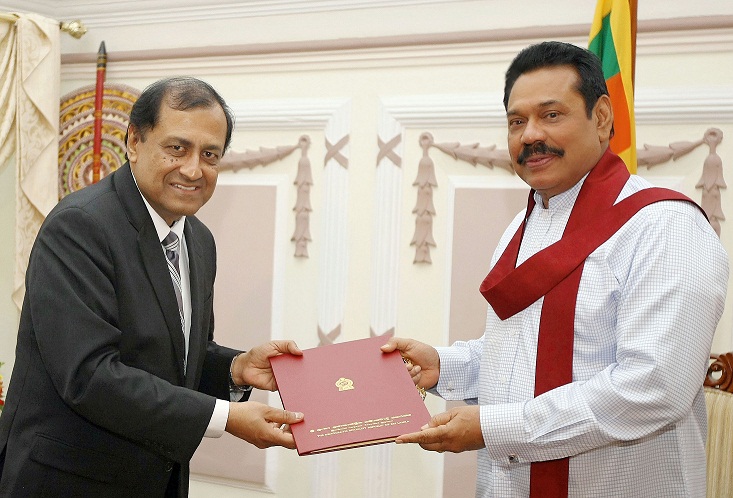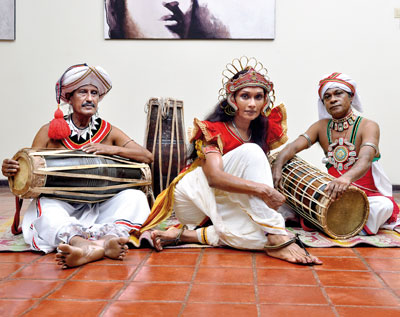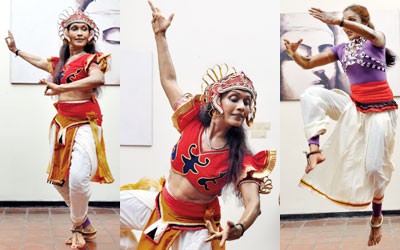Taking Sri Lanka’s Culture to the World
True ease in writing comes from art, not chance
As those move easier who have learned to dance
-Alexander Pope An Essay on Criticism
Recently there were media reports that leaders of cultural, educational, welfare, sports, youth and political associations in Paris gathered at the Embassy of Sri Lanka in France to meet and greet Sri Lanka’s Ambassador. It was reported that while addressing the large gathering of invitees, Ambassador Hangawatte expressed his pleasure at welcoming everyone to the friendly, informal meeting.
The Ambassador expressed the need for all community members to come together for the advancement of our motherland irrespective of ethnic and religious diversities or different political ideologies. Addressing questions submitted to him by Sri Lankan associations,

President Mahinda Rajapaksa handed over (on April 3) the accreditation papers to the new Sri Lankan Ambassador to France Karunaratne Hangawatte, who is currently a professor based in the United States – Photo taken from Asian Tribune
Ambassador Hangawatte detailed some of the short term and long term plans to promote Sri Lanka’s culture in France. He gave examples of traditional art, handicraft, photography and sculptures which could be promoted through exhibitions while adding that cultural similarities between multi ethnic communities in Sri Lanka could be highlighted through diverse forms of performing art such as music, dance and cinema, focusing on the goal of strengthening peace and reconciliation in Sri Lanka.
It is laudable that our Ambassador in France intends to take the initiative in taking Sri Lanka’s culture to France and other Sri Lankan missions abroad should follow suit to create awareness of the rich cultural heritage of our motherland to the international community thereby helping to dispel the bad image of our country propagated through the diaspora machinations operated mainly by the TGTE.
It is to be noted that Sri Lankan culture has been enriched to the most part by the dancers of Sri Lanka. The origin of the dances of Sri Lanka lies with the indigenous people of Sri Lanka, the Wanniyala-Aththo or the Vaddas and ” yakkas” (“those who work with iron”).There are three main styles of Sri Lankan classical dance:
The Kandyan Dance of the Hill Country, known as Uda Rata Natum;
The low country dances of the southern plains, known as Pahatha Rata Natum;
Sabaragamuwa dances, or Sabaragamuwa Natum.
Kandyan dance takes its name from Kandy, the last royal capital of Sri Lanka. This genre is today considered the classical dance of Sri

Khema (M) Sri Lanka’s renowned ritual dancing exponent flanked by geta bera drummer (L) and Pahatha rata bera drummer (R)
Lanka. In Sanskrit terminology it is considered pure dance (nurtta); it features a highly developed system of “tala” (rhythm), provided by cymbals called “thalampataa”. There are five distinct types; the ves, naiyandi, uddekki, pantheru, and vannams.
The three classical dance forms differ in their styles of body-movements and gestures, in the costumes worn by the performers, and in the shape and size of the drums used to provide rhythmic sound patterns to accompany the dancing.The drum used in Kandyan dancing is known as the ‘Geta Bera’, the drum in Ruhunu dancing as the “Yak Bera”, and drum in Sabaragamu dancing as the “Davula” (the word Bera or Bereya in Sinhala means “Drum”) The Geta Bera is beaten with the hands as is also Yak Bera, while the Davula is played with a stick on one side and with one hand on the other side; the Geta Bera has a body which tapers on both sides while the Yak Bera and the Davula both have cylindrical bodies.
The main distinguishing feature between Kandyan and Sabaragamu dancing, and Ruhunu dancing, is that Ruhunu dancers wear masks.
The word “vannam” comes from the Sinhala word “varnana” (descriptive praise). Ancient Sinhala texts refer to a considerable number of “vannams” that were only sung; later they were adapted to solo dances, each expressing a dominant idea. History reveals that the Kandyan king Sri Weeraparakrama Narendrasinghe gave considerable encouragement to dance and music. In this Kavikara Maduwa (a decorated dance arena) there were song and poetry contests.
It is said that the kavi (poetry sung to music) for the eighteen principal vannams were composed by an old sage named Ganithalankara, with the help of a Buddhist priest from the Kandy temple. The vannams were inspired by nature, history, legend, folk religion, folk art, and sacred lore, and each is composed and interpreted in a certain mood (rasaya) or expression of sentiment. The eighteen classical vannams are gajaga (“elephant”), thuranga (“horse”), mayura (“peacock”), gahaka (“conch shell”), uranga (“crawling animals”), mussaladi (“hare”), ukkussa (“eagle”), vyrodi (“precious stone”), hanuma (“monkey”), savula (“cock”), sinharaja (“lion”), naga (“cobra”), kirala (“red-wattled lapwing”), eeradi (“arrow”), Surapathi (in praise of the goddess Surapathi), Ganapathi (in praise of the god Ganapathi), uduhara (expressing the pomp and majesty of the king), and assadhrusa (extolling the merit of Buddha). To these were added samanala (“Butterfly”),bo (the sacred bo tree at Anuradhapura, a sapling of the original bo tree under which Buddha attained enlightenment), and hansa vannama (“swan”). The vannam dance tradition has seven components. dog dance cat dance lion dance ostrich dance parrot dance etc
Mask of the demon Maha Sohona used in the Tovil Healing Ritual in Sri Lanka The “Devil Dances” are an attempt to respond to the  common belief that certain ailments are caused by unseen hands and that they should be chased away for the patient to get cured. If an individual or a family is not doing well, the village-folk believe that it’s because that person or the family is being harassed by unseen hands. A ‘thovil’ ceremony is the answer.
common belief that certain ailments are caused by unseen hands and that they should be chased away for the patient to get cured. If an individual or a family is not doing well, the village-folk believe that it’s because that person or the family is being harassed by unseen hands. A ‘thovil’ ceremony is the answer.
The ‘thovil’ can be a simple ritualistic ceremony at home restricted to family and immediate neighbours or involving the whole village like the ‘gam-maduva’ or the ‘devol-maduva’ which is closely linked to the worship of gods. Masked dancers take part in at least two of the well-known ‘thovil’ ceremonies referred to as the ‘Maha Sohon Samayama’ and the ‘Gara Yakuma’. The mention of ‘Maha Sohona’ frightens the people since he is believed to be the demon of the graveyards.
The performer disguises himself as a bear and wears a mask and a dress to resemble one. Often the ‘thovil’ involves the ‘sanni’ dances where all the dancers wear masks. The ‘daha ata sanniya’ refers to sixteen ailments with a demon being responsible for each one of them.
Dancers wearing masks take part in processions while at certain ceremonies, masks are used to depict different characters. Of later origin are the masks worn by children and teenagers at street performances during Vesak. Popularly known as ‘olu bakko’ for the simple reason that oversize masks are worn, these performances keep the younger-folk, in particular, entertained.
Apart from the classical dance forms there are also folk dances, which are associated with folk activities and festivities.Leekely (stick dance),kalagedi (pot dance), Raban (a hand drum), polkatu (a coconut), folk dances prevalent at the present time.
There is also in the low country a dance-drama called Kolam in which the performers wear masks depicting animals or people such as kings or high officials, and provides amusement and social satire. It has been suggested by scholars that Kolam may have developed from the ritual known as Sanni Ykuma and had later become a dance-drama independent of ritual elements.
The classical dance forms are associated with performance of various rituals and ceremonies which are centuries old and are based on folk religion and folk beliefs going back to before the advent and of Buddhism and its acceptance by the Sinhalese people in the 3rd century BC. These rituals and ceremonies reflect the values, beliefs and customs of an agricultural civilization.
The pre-Buddhistic folk religion consisted of the belief in a variety of deities and demons who were supposed to be capable of awarding benefits and blessings but also causing afflictions and diseases. Accordingly they had to be either propitiated or exorcised with offerings and the performance of rituals and ceremonies.
Kandyan dancing has its origins in the ritual known as the Kohomba Kankariya, which is performed to propitiate the deity known as Kohomba for the purpose of obtaining relief from personal afflictions or from communal calamities such as pestilence. Although this ritual is rarely performed at the present the various dances associated with its performance could be seen in the Kandy Perahara, and annual religion-cultural event which takes place in the city of Kandy in honour of the sacred tooth-relic of the Buddha housed in the Dalada Maligawa, the Temple of the Sacred Tooth Relic. Ruhunu dancing has its origins in the rituals of the Devol Maduwa – used to propitiate the Deity Demon Devol – and in exorcistic rituals known as the Rata Yakuma and the Sanni Yakuma – associated with various demons who are supposed to cause a variety of afflictions and incurable illnesses. Sabaragamu dancing is associated with the ritual known as the Gam Maduwa, which is performed to propitiate the goddess Parrini. The purpose is to obtain a good harvest or to ward off evil or to be rid of and infectious disease
The above concise narrative although inadequate illustrates in a nutshell the richness of Sri Lanka’s dance culture which has earned international accolades. Tourists arrive in large numbers to visit our country to witness the Kandy Perhahara, which is a pageant that includes almost all the dance forms of our nation. In this connection great dancers like Chitrasena and Vajira, Panibhrataha and their students foremost among them Channa Wijewardene and Upuli have helped immensely to take our dance culture abroad. Dancing is taught as a subject in our universities like Kelaniya, Sree Pali campus of the University of Colombo and the University of Performing Arts which award degrees in dancing. Sri Lanka also has great bharatha natya dancers which is a culture that hails from our neighbour India. The famous academy of dancing Shanthiniketan in India has helped greatly in training our dancers in this field. The government of Sri Lanka through its Cultural Affaires Ministry and the Sri Lankan Missions abroad is performing a great service to our nation by taking Sri Lanka’s culture to the world.
Lakshman I.Keerthisinghe LLB, LLM.MPhil,
Attorney-at-Law
